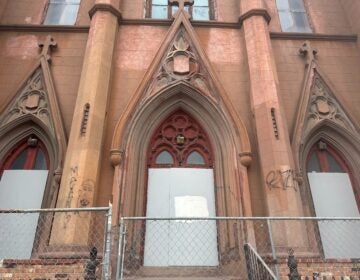Look Up! 18th century housing in trendy Southwark
May 23, 2010
By Alan Jaffe
For PlanPhilly
“Look Up” is a PlanPhilly feature that encourages appreciation of our architectural and historical environment. Each week, the photo essay will focus on a different Philadelphia area neighborhood and its distinctive building styles and details, all of which make up the physical fabric of the city and region.
Nearly three decades before the signing of the Declaration of Independence, a group of small tenement buildings were erected by George Mifflin along Pemberton Street near Front. The homes had one room per floor and two apartments in each building. Mifflin sold the buildings and the large lot behind them to John Workman, who in 1812 constructed three larger houses along 742-46 Front St. The lot became a common central courtyard.
The early occupants of the tiny streets and alleys of the burgeoning Southwark community were mariners, ship builders and carpenters employed on the waterfront, in addition to tavern keepers, blacksmiths, bricklayers and artisans. The building boom began in the mid-18th century and continued through the early 1900s with the wave of immigrants to the city.
Lydia S. Clark, an advocate for housing reform, purchased the buildings from the Workman family in 1906. They were later placed under the supervision of the Octavia Hill Association, which was named for the London activist for safe, sanitary, affordable housing. The association continues to offer the Workman Place homes as rental properties in the now trendy residential and commercial neighborhood.
On the oldest buildings along Pemberton, the year of their construction and an “M” for Mifflin are still visible in the brick design above the surrounding wall.

The oldest buildings of Workman Place, along Pemberton near Front Street, were erected by William Mifflin in 1748.

The 18th and 19th century buildings surround a central courtyard that offers a communal gathering place and small private yards.

Workman Place consists of two- and three-floor rental housing.

The first floor of the older homes contained one room.

An ancient tree has fused with the base of one of the Workman Place homes.

John Workman erected three more elaborate houses along Front Street in the early 19th century.

Contemporary iron gates lead into Workman Place.

Tiny, two-floor, 18th century houses can be found throughout the Southwark neighborhood.

The date of the earliest buildings is found in the brick design on the Pemberton Street side.

George Mifflin’s mark remains on the early rental units.
“Look Up” and check out Henry Disston’s company town
“Look Up: and check out Spruce Hill
“Look Up” and check out Green Street
“Look Up” and check out West Laurel Hill
“Look Up” and check out Parkside
“Look Up” and check out Awbury Arboretum
“Look Up” and check out Nicetown
“Look Up” and check out Greenbelt Knoll
“Look Up” and check out Overbrook Farms
“Look Up” and check out Girard Estate
“Look Up” and check out Rittenhouse/Fitler Square
Contact the writer at alanjaffe@mac.com.
WHYY is your source for fact-based, in-depth journalism and information. As a nonprofit organization, we rely on financial support from readers like you. Please give today.
















